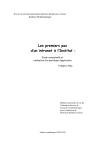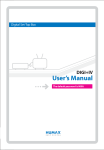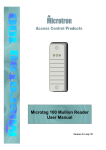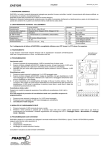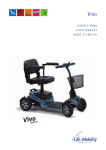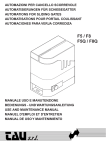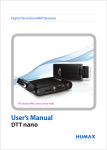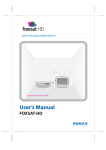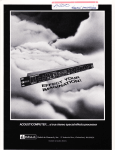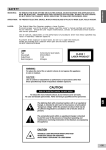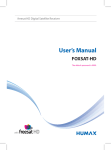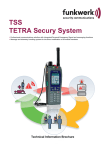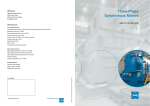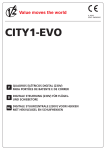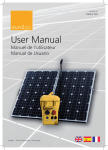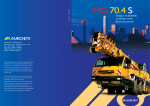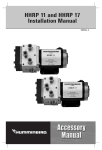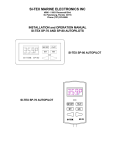Download Service Manual - Hans H. Meyer GmbH
Transcript
stapleranbaugeräte forklift truck attachments équipements hydrauliques heftruck voorzetapparatuur Fork Positioner Type 6-25 Operating and Service Instructions 625/02/07-Ver.GB01-GB1 - GB - 625/02/07-Ver.GB01-GB2 Hans H. Meyer GmbH - GB2 - Hans H. Meyer GmbH Titel Operating and Service Instructions Product Fork Positioner Product type 6-25 Issued by Hans H. Meyer GmbH Gittertor 14 D-38259 Salzgitter Contact Tel.: Fax: +49 (0)5341 803-0 +49 (0)5341 803-196 Mail: Web: [email protected] www.meyer-world.com Hans H. Meyer Ltd. Unit 15, Haigh Park, Whitehill Ind. Est., Reddich, UK-Stockport SK4 1QR Tel.: Fax: +44 (0)161 4806464 +44(0)161 4804082 Mail: [email protected] This document is copyrighted. All rights reserved. This document may not be copied, duplicated, translated or transformed into an electronic medium or other machine-readable form, either as a complete document or as segments of it, without the permission of Hans H. Meyer GmbH. Subject to change without notice. … about this Documentation or to the Product may be sent to the above address. Further information … covering other products from Hans H. Meyer can be found on our Internet page www.meyer-world.com or by phoning us on +49 (0)5341 803-0 or +44 (0)161 4806464. 625/02/07-Ver.GB01-GB3 Suggestions and tips - GB3 - 625/02/07-Ver.GB01-GB4 Hans H. Meyer GmbH - GB4 - Hans H. Meyer GmbH 625/02/07-Ver.GB01-GB5 List of Contents Scope of delivery .................................................................................................. 7 Standard accessories ..................................................................................... 7 Optional accessories ..................................................................................... 7 Notice for the reader............................................................................................. 7 Validity .......................................................................................................... 8 Illustrations .................................................................................................... 8 Accentuated text ........................................................................................... 8 Product description ............................................................................................... 9 Product identification ..................................................................................... 9 Intended application .................................................................................... 10 Product description ..................................................................................... 10 Functional description .................................................................................. 10 Possible applications ................................................................................... 11 Operator classification / Qualification ........................................................... 11 Period of operation ..................................................................................... 11 Forklift truck requirements ........................................................................... 11 Safety ................................................................................................................. 12 Qualification of personnel ............................................................................ 12 Global safety ............................................................................................... 12 Personal safety ............................................................................................ 13 Product safety ............................................................................................. 14 Transport and mounting ....................................................................................... 16 Delivery and transport ................................................................................. 16 Packaging ................................................................................................... 16 Unpacking .................................................................................................. 16 Mounting / Installation ......................................................................................... 16 Notice to ecological operation ..................................................................... 16 Mounting and connections to the forklift truck .............................................. 16 Initial operation ................................................................................................... 20 Initial operation ........................................................................................... 20 Pressure settings ................................................................................................. 20 Setting the pressure ..................................................................................... 21 Trail operation..................................................................................................... 23 Conducting a trail ........................................................................................ 23 Preparation for continuous operation ................................................................... 23 Commissioning ............................................................................................ 23 Handling (continuous operation) .......................................................................... 24 Operational pause ............................................................................................... 24 Short pause ................................................................................................. 24 Restarting operations ................................................................................... 24 Decommissioning ................................................................................................ 25 Decommissioning the attachment .................................................................. 25 Removing the attachment from the forklift truck ............................................ 25 Disposal ............................................................................................................. 26 Disposal of the attachment ........................................................................... 26 Maintenance and servicing................................................................................... 26 Preventive measures .................................................................................... 26 Regular inspections before starting work ...................................................... 27 Regular maintenance .................................................................................... 27 - GB5 - Hans H. Meyer GmbH 625/02/07-Ver.GB01-GB6 Addendum.......................................................................................................... 28 Torque table for bolted fastenings ................................................................ 28 Hydraulic circuits ......................................................................................... 29 For your notes .................................................................................................... 30 - GB6 - Hans H. Meyer GmbH Scope of delivery The Fork Positioner, in future known as the attachment, is delivered completely assembled and ready for use. Standard accessories The attachment is delivered without accessories. Optional accessories Optional accessories and spare parts obtainable on request. 625/02/07-Ver.GB01-GB7 Further information covering optional delivered accessories may be found in the documentation delivered herewith. - GB7 - Hans H. Meyer GmbH Notice for the reader This document contains information and the code of conduct required for safely operating this attachment. We advise reading this document completely before operating the attachment. Keep this document ready for reference at all times. In order to operate this attachment effectively, the following aspects are covered in this document: - Transportation of the attachment, mounting and trail operation. - Working with the attachment. - Maintainance and servicing the attachment. Validity This document is valid for: - the operating company. - all persons working on or operating this attachment. Illustrations Some of the illustrations in this document show the attachment in a simplified or diagrammatic manner. Accentuated text Varying circumstances have been accentuated. Symbols mark important information. The following examples show the principal accents and symbols used: 1. Step, an operational sequence. 2. Step, the next operational sequence. etc. These are health and safety notices! Warning notices point out dangers to life and limb or damage that may occur to the attachment through improper use. 625/02/07-Ver.GB01-GB8 This is an indication of further available information. Such references are intended to help simplify working with the attachment. - GB8 - Hans H. Meyer GmbH Product description Product identification All attachments are clearly marked with a identification label. The identification label is attached to the front righthand side of the backplate as seen from the operators driving position. Identification label 625/02/07-Ver.GB01-GB9 The identification label bears the following information: - Manufacturer and address - Warning notice to load capacity - Year of manufacture - Type - Serial number - Load capacity - Load centre - Mass - Centre of gravity - Hydraulic operating pressure - CE-Symbol - Works number, if applicable - GB9 - Hans H. Meyer GmbH Intended application The Fork Positioner is an attachment for forklift trucks which replaces the trucks own forks and is used to transport loads. A different application or an application far in excess of the intended rating is not in compliance. Misappropriate use in particular: - Any kind of transportation of persons. - Carrying loads in excess of the maximum stated on the identification label. - Displacing loads sideways that are not free of the ground. - Operating an attachment that is not correctly mounted on the forklift truck. - Operating a defective attachment. - Operating an attachment on a defective forklift truck. - Handling by unqualified persons. Product description The attachment has a very sturdy and torsion-resistant basic chassis. Incorporated in this basic clamp body are two horizontal chromed guide bars. Mounted on the guide bars are two ajustable fork carriers which are conform with ISO 2328 and enables standard forks to be used. Optionally, the forks can also be bolted on. The attachment also has an upper mounting hook which extends across the whole width of the back structure, which provides more ridgidity and allows the attachment to be mounted on forklift trucks with narrower fork carriages. The lower mounting hooks can also be of the quick release type. 625/02/07-Ver.GB01-GB10 Functional description The load arms are adjusted horizontally by hydraulic cylinders which are operated from the drivers position on the forklift truck. To ensure safe transportation, the load must be lifted with the forks adjusted to the widest possible setting. The hydraulic load arms can also be adjusted horizontally as a pair, lateral to the forklift trucks longditudinal axis, this allows the operator to correct misalignment of the forklift truck during his approach. This integrated side shifting only applies when the load arms are at an intermediate position between the opening range of the attachment. The resulting reserve stroke of the adjusting cylinders is then available for side shifting. The hydraulic circuit has an integral lockvalve which holds the load arms in the position to which they have been adjusted. - GB10 - Hans H. Meyer GmbH Possible applications This type of attachment may only be used for the transportation of loads that can to be carried on forks. Suitable loads, are loads to be carried on pallets, in boxes or crates, in tubs, bins or in frames. These loads must have suitable load holding facilities such as pockets or must be elevated to accept the forks. Other suitable loads are those elevated by chocks or in shelves, such as bar sections or where the load itself can be entered e.g. large pipes. It is not allowed to clamp loads of any kind, using only the tips of the load arms! Operator classification / Qualification As an operating company, you must have adequate qualified personnel to operate forklift truck attachments. Further details to this subject may be found in the following chapters of this instruction manual. In the case of not having qualified personnel or furthermore having doubts to this subject, you may ask Hans H. Meyer GmbH (or Hans H. Meyer Ltd.) for assistance. Period of operation The attachment is designed for uninterupted operation on forklift trucks. Forklift truck requirements The forklift truck carriage dimensions must comply to the ISO Standard 2328. The following values may help for the orientation: - Reference dimension h3. - Hydraulic delivery volumes. A Clas s h3 tol. ISO 2328 mm mm 2 381 - 1 3 476 - 1,5 4 597 - 1,5 B C Type Hydr.-Vol. l / min. 6 - 2504 30 ± 5 6 - 2506 35 ± 10 6 - 2509 40 ± 10 6 - 2512 50 ± 10 Mounting classes, Truck Carriage ISO 2328 625/02/07-Ver.GB01-GB11 The hydraulic delivery volume should be approx. 30 l/min. Lower hydraulic delivery volumes will result in slower and irregular load arm travel speeds. Higher hydraulic delivery volumes result in excessive oil temperatures which will cause greater wear and less efficiency in the Hydraulic system. - GB11 - Hans H. Meyer GmbH Safety Qualification of personnel All persons either working on or with the attachment must be qualified to do so. Operating personnel: Must have adequate instruction in the functional and operational sequences. Knowledge of operational sequences while executing the required work operations. Service personnel: Established knowledge of mechanical engineering, electrotechnology and hydraulics. Authorisation to comission the attachment according to the relevant standards of technical safety. Established knowledge of the composition and functioning of the attachment. As an operator of attachments, it must be ensured that all persons involved in the mounting, operating, servicing or repairing of attachments have thoroughly read and understood the relevant parts of the Operating and Service Instructions. Global safety This attachment complies to the current state of science and technology. It is dependable and safe to operate. Even so, it could still harbour possible dangers to persons or faults may occur. Attention to the Operating and Service Instructions is therefore mandatory. The manufacturer´s Operating and Service Instruction manual is a conduct of behavior for the operators of attachments and for all persons involved in the mounting, operating, servicing or repairing of attachments. 625/02/07-Ver.GB01-GB12 Risk of injury through improper application! Be aware that persons may be at risk through improper use. Furthermore, damage to the cargo or the attachment may also result from incorrect handling. - GB12 - Hans H. Meyer GmbH Personal safety Danger to life through crushing and shearing! The life of persons may be endangered through the crushing and shearing actions that occur during the movements of the load arms. The attachment may only be activated, when the danger zone is free of all persons! 0 ,5m 0 ,5m 0 ,5m 0 ,5m Danger zone Dangers through crushing! You may be in danger of being crushed by the attachments own net weight. Always safeguard the attachment against the possibility of it falling over or falling off. The attachment has a substantial net weight. This may cause dangerous crushing actions during mounting or storage proceedures. Taking this into consideration, initiate the appropriate safety precautions. Dangers through poisoning! Skin contact with lubricants is health threatening. Avoid all skin contact with lubricants and hydraulic oils. 625/02/07-Ver.GB01-GB13 The technical features of all modern lubricants and hydraulic oils can cause serious illness if swallowed or come into contact with the skin. - GB13 - Hans H. Meyer GmbH Product safety Damages caused to products and the attachment! Incorrect handling of the attachment is likely to cause damage to the product. Always apply the attachment correctly to the product. Always use the attachment and its functions, in the correct form and manner. Note the following instructions: - Ensure that the attachment is mounted securely to the forklift truck. - When ”opening” the attachment, be sure not to shift other loads sideways. Loads being forced sideways while opening the load arms The load arms and attachment are not designed to withstand this kind of overloading, serios damage may be caused to both. Loads on the ground, must not be moved sideways with the “sideshift” function. Loads being forced sideways while sideshifting 625/02/07-Ver.GB01-GB14 - - GB14 - Hans H. Meyer GmbH - No loads are to be clamped between the tips of the load arms. Loads being clamped between the tips of the load arms - During transportation, the load must rest against the backrest, this applies especially to loads that reach the maximum load capacity of the attachment, this may otherwise cause a change in load centre which in turn causes the attachment to be overloaded and the forklift truck may topple forwards. 625/02/07-Ver.GB01-GB15 The load against the fork backs - GB15 - Hans H. Meyer GmbH Transport and mounting Delivery and transport The Hans H. Meyer GmbH delivers the attachment on a pallet. During transportation, the attachment must be either - on the original pallet. - securely mounted on the forklift truck. - hung in appropriate lifting gear, i.e. with ropes or slings. Packaging Generally, the attachment is delivered on a suitable transport pallet and secured with security bands, but without any further packaging. In some cases, foil packaging may be used to avoid corrosion. Unpacking Remove all existing packaging. Dangers through overturning! After the removal of all security bands, the attachment is in a free standing state and could possibly tip over. - Be sure the pallet with the attachment is on a level surface. - Support the attachment using lifting gear or similar before removing the security bands. - Remove the security bands. - Dispose of any packaging materials in the approved manner. - Further steps are to be taken from the following chapters. Mounting / Installation Notice to ecological operation Enviromental pollution through lubricants! Great attention must be paid in stopping hydraulic oil and lubricants from polluting the environment. Mounting and connections to the forklift truck Personal injury! Installation work. 625/02/07-Ver.GB01-GB16 Requirements: - Arrange the pallet with the attachment, so that the forklift truck can drive behind the back. - Make sure that the attachment cannot fall over. - GB16 - Hans H. Meyer GmbH Follow the next steps: 1. Apply a lifting rope or sling arround the upper guide bars, or screw ring bolts into the threaded holes in the top of the attachment frame to lift the attachment with hooks. With ring bolts and hooks With lifting sling 625/02/07-Ver.GB01-GB17 2. Unbolt and remove the lower mounting hooks. Fixing bolts for the lower mounting hooks - GB17 - Hans H. Meyer GmbH 3. Drive the forklift truck centrally behind the hanging attachment 4. Lower the attachment onto the fork carriage of the truck until the upper mounting hooks have completely closed over the carriage profile. Be sure that the centre locking pin of the attachment locates in the central notch of the carriage. Centre locking pin Central slot of the fork carriage 625/02/07-Ver.GB01-GB18 5. Refit the lower mounting hooks. 6. Now tighten up the bolts with a torque wrench. 7. Connect the hydraulic jumper hoses to the attachment and make the to the repective connections to the forklift truck. - GB18 - Hans H. Meyer GmbH Hydraulic jumper hose connections 625/02/07-Ver.GB01-GB19 Connection 1: Load arm adjustment Connection 2: Side shifting - GB19 - Hans H. Meyer GmbH Initial operation Initial operation Follow the next steps: 1. Check the oil level in the forklift truck, as the attachment withdraws a certain volume of hydraulic oil from the trucks tank. 2. When neccesary, top up the hydraulic oil. 3. Take all functions, that being all cylinders, to the end of their travel. 4. Respectively, keep the hydraulic pressure constant for 10 seconds. 5. Inspect all hydraulic couplings for leakages. 6. When neccesary, retighten any leaking hydraulic couplings. Pressure settings The preliminary working pressure neccesary to operate the side shifting function of the load arms is preset in the factory. The diversity of hydraulic systems and forklift trucks and the different perfomance rates of these systems, requires indiviual pressure settings. Ideally, a maximum pressure of 120 bar should not be overstepped for any of the functions. This maximum pressure is to set on the forklift truck. It is not always neccesary to use the maximum hydraulic working pressure. The pressure settings should in fact be adjusted to suit the load type, this will guard against damage and prolong the working life of the attachment. 625/02/07-Ver.GB01-GB20 Valve with cap nut - GB20 - Hans H. Meyer GmbH Setting the pressure Requirements: - Prepare a load with the maximum permitted load capacity. Follow the next steps: 1. Remove the existing cap nuts. Valve with cap nut removed 2. Slacken off the locknut. Slackening off the locknut 625/02/07-Ver.GB01-GB21 3. Completely unscrew the adjusting screw (anti-clockwise). Unscrew the adjusting screw - GB21 - Hans H. Meyer GmbH 4. Now lift the maximum load in preparation for setting the side shifting function 5. Operate the sideshift lever. 6. Slowly turn the adjustment screw for the side shift function clockwise until the load starts to move at an adaquate speed. 7. Lock the adjustment screw with the locknut and refit the cap nut. Tightening the locknut The cap nut has been refitted 625/02/07-Ver.GB01-GB22 8. All pressure settings have now been correctly adjusted. - GB22 - Hans H. Meyer GmbH Trail operation During the trail operation, the verification of the load bearing capacity is to be carried out using the maximum load stated on the identification label of the attachment. However, if the forklift truck rating plate specifies a lower load carrying capacity, only loads to or below this specification may be transported! Conducting a trail Requirements: - Choose a suitable load for the trail opertation. - The load chosen must be of the same type as the load to be transported during normal daily operations. Follow the next steps: 1. Opened the load arms to an approriate width to safely lift the load. 2. Lift the load to a height of approx. 10 cm off the floor. 3. Side shift the load to each side and hold the forklift truck lever in its fully deflected position for approx. 10sec. 4. Inspect all hydraulic elements and connctions for leaks. 5. If all functions work correctly and no leaks are apparent, the attachment may now be put into operation. Should the trail be a failure, check the pressure settings or reset them as required. If no serviceable result can be obtained, inform the appropriate supervisor responsible. Preparation for continuous operation Commissioning Regular checks before starting work: - Inspect the complete hydraulic system for leaks. - Inspect for damage to hydraulic cylinders and fittings such as hoses, pipes, valves and connectors. - Inspect for wear and cracks in the load arms. - Inspect for deformation of any parts; indication of a possible accident. - That the attachment is well seated on the forklift truck and that the retaining bolts for the upper and lower hooks are screwed in tightly (see addendum; Torque Table). 625/02/07-Ver.GB01-GB23 If damage is detected: - By no means is the attachment to be used! - Inform the appropiate supervisor responsible immediately! - GB23 - Hans H. Meyer GmbH Handling (continuous operation) The attachment on its own, not attached to a forklift truck, cannot be activated and can therefore not be operated. Because of the wide variety of forklift trucks and the differing operating functions (levers, pedals and switches) etc., it is necessary that the operating instructions for these functions be taken from the forklift truck instruction manual. Danger to life - Adhere to all safety regulations. - Pay attention to this instruction manual. The attachment may only carry loads in relation to its load centre that do not exceed the maximum load stated on the attachment identification label. If reduced load capacities are stated on the rating plate for forklift trucks with attachments, then these specify the maxmimum loads to be carried. Suitable load types and their handling can be found in chapter “Product description”. In order to avoid further damage occuring after an accident, a trained person must thoroughly inspect all parts of the basic unit for distortion and fractures. Operational pauses Short pause A short pause can be defined as switching off the forklift truck to end a working day or before the start of a work break. In these or similar cases, follow the instructions in the forklift truck instruction manual. Dangers caused by falling or slipping loads! - No loads may be resting on the load arms while the attachment is standing idle. - Observe the instructions in the forklift truck instruction manual. - Relieve the attachments hydraulic system of pressure (see forklift truck instruction manual). 625/02/07-Ver.GB01-GB24 Restarting operations See chapter “Preparation for continuous operation”. - GB24 - Hans H. Meyer GmbH Decommissioning To decommission an attachment means that the attachment is removed from the forklift truck for either: - being refitted at a later date. - being fitted to a different forklift truck. Decommissioning the attachment Requirements: - a suitable vessel to be at hand to catch escaping hydraulic oil. - either sawdust or a similar binding agent is at hand to absorb leaked hydraulic oil. - a suitable transport pallet is at hand. Follow the next steps: 1. With the help of a high-pressure cleaner, remove all dirt and the remains of lubrication from the guide profiles. 2. Leave the attachment to dry in the open air or speed up the procedure by using compressed air. 3. Apply fresh lubricant to the guide profiles (for suitable lubricants, see the chapter on ”Maintenance and Servicing”). 4. Take all relevant moving parts through their movements to disperse the lubricants evenly. 5. Spray all blank metallic parts with a commercial preservative intended for this purpose. 6. Switch off the forklift truck. 7. Relieve the hydraulic system of pressure (see the instructions in the forklift truck manual). Removing the attachment from the forklift truck 625/02/07-Ver.GB01-GB25 Risk of injury through hydraulic oil spillage! Hydraulic oil may be spilled onto the floor when disconnecting the hoses, thereby increasing the danger of slipping. Skin contact may cause chemical burns. Follow the next steps: 1. Wear your personal protective gear. 2. Disconnect the hydraulic jumper hoses from the forklift truck. 3. Catch any leaking hydraulic oil with an appropriate vessel. 4. Any spilled hydraulic oil must be bound using the appropriate binding agent and disposed of in accordance to regulations. 5. Remove the bolts from the lower mounting hooks. 6. Secure the attachment with suitable lifting tackle and by tilting the mast forwards and lowering the fork carriage, reverse the forklift truck away from under the upper mounting hooks. 7. Lower the attachment onto the transport pallet and safeguard it against falling over e.g. by tying it down. 8. To safeguard against loss, refit the lower bolts and mounting hooks. 9. Store the attachment in a dry place and cover it using a suitable covering. - GB25 - Hans H. Meyer GmbH Disposal After the expiration of the assigned working period or working life has been reached, the attachment may be decommissioned and scrapped. Disposal of the attachment Follow the next steps: 1. Decommission the attachment (see the last chapter). 2. Take appropriate measures to ensure that the attachment is kept from being used again. 3. Dismantle the attachment professionally. 4. Seperate all individual parts and scrap them according to the materials used. 5. Dispose of all surplus fluids according to regulations. Maintenance and servicing Service and repairs at regular intervals are the vital key to prolonging the attachments working life. Breakdown! Repairs to major functional elements such as hydraulic cylinders and valves, must only be carried out by persons trained to do so. Danger to life! Work on the hydraulic system must only be carried out after first depressurising the hydraulic circuits. Escaping jets of high pressure hydraulic oil can cause bad injuries if the hydraulic circuit is not first depressurised before working on it! Preventive measures A higher rate of wear, possibly causing corrosion to the guide profiles, will result from attachments operating in extremely dirty environments, this can also have negative effects on other blank metallic surfaces, e.g. piston rods, causing leaks around the packing seals. 625/02/07-Ver.GB01-GB26 Quite often, dirt collecting on the attachment is caused by the front wheels of the forklift truck, which throw up dirt and grit from the road surface. It is therefore advisable to fit the truck with suitable mudguards. - GB26 - Hans H. Meyer GmbH Regular inspections before starting work The following points must be accounted for before starting work: - Leakages in hydraulic cylinders, valves and the various other hydraulic connections. - Deformation and cracks in the load arms. - The correct mounting of the attachment on the forklift truck and especially the fastening bolts for the mounting hooks. If damage is detected, inform the appropiate supervisor responsible immediately! Regular maintenance Lubrication and maintenance intervals are dependant on the workload of the application and external influences e.g. the effects of dust and dirt, fluctuations in temperature change and weather conditions. Follow the next steps: 1. With the help of a high-pressure cleaner, remove all dirt and the remains of lubrication from the guide profiles. 2. Leave the attachment to dry in the open air or speed up the procedure by using compressed air. 3. Inspect the attachment for leaks in hydraulic cylinders, valves and the various other hydraulic connections. 4. Inspect the load arms, forks and the main frame for deformation and cracks. 5. Inspect all fastening bolts, if necessary by using a torque-wrench to check tightness (a torque table can be found in the addendum). 6. Apply fresh lubricant to the guide profiles. Be sure to use grease that will not thicken or harden when exposed to very low temperatures. Grease recommendations: - GENERAL-PURPOSE Class 2 7. Take all relevant moving parts through their movements to disperse the lubricants evenly. 8. Spray all blank metallic parts with a commercial preservative intended for this purpose. 625/02/07-Ver.GB01-GB27 Always give the type and serial number (see product identification label) when technical assistance or spare parts are required! - GB27 - Hans H. Meyer GmbH Addendum Torque table for bolted fastenings When tightening cylinder and hexagon type bolts, the correct torque must be obtained by using a torque wrench. The necessary torque requirements are classified by their sizes and strengths in the table below. Old and used bolts must always be replaced by new ones. Anzie h-Dre hmome nte / torque table / couple s de s e rrage Ge winde thre ad file t 8.8 3,1 N m 6,1 N m 10,4 Nm 25 N m 51 N m 87 N m 140 Nm 215 Nm 300 N m 430 N m 580 N m 740 N m 1100 Nm 15 0 0 N m 4 5 6 8 10 12 14 16 18 20 22 24 27 30 10.9 4,5 N m 8,9 N m 15,5 Nm 37 N m 75 N m 130 Nm 205 N m 310 Nm 430 N m 620 N m 830 N m 1060 Nm 15 5 0 N m 2 10 0 N m 12.9 5,3 N m 10,4 Nm 18 Nm 43 N m 87 N m 150 Nm 240 N m 370 N m 510 Nm 720 N m 970 N m 1240 Nm 1850 Nm 2500 N m 100 --10 Nm 18 Nm 37 N m 80 N m 12 0 N m ------------- 625/02/07-Ver.GB01-GB28 M M M M M M M M M M M M M M Für / for / ave c Schraube n / bolts / vis Ve rbus Ripp Fe s tigke its klas s e clas s of s tre ngth Force de ré s is tance - GB28 - Hans H. Meyer GmbH Hydraulic circuits The reference markings on the hydraulic valve are interpretated as follows: = = = = = open load-arms close load-arms side shifting to the left and right cylinder connections to the piston-head side cylinder connections to the piston-rod side 625/02/07-Ver.GB01-GB29 A1 + A2 B1 + B2 S1 + S2 ZA1 + ZA2 ZB - GB29 - Hans H. Meyer GmbH 625/02/07-Ver.GB01-GB30 For your notes - GB30 -






























